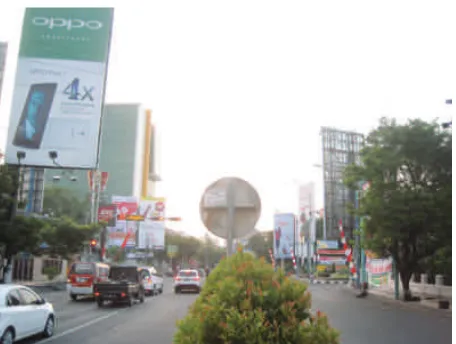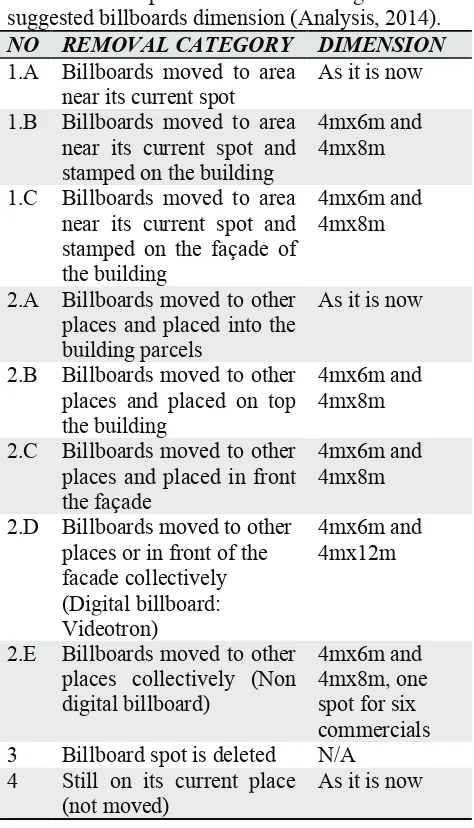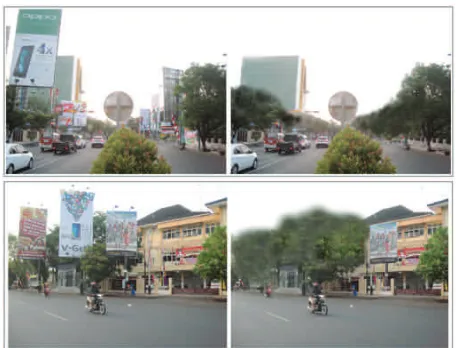1
Regulating Billboards Outside Public
Infrastructure Seen From City Image Point
of View: Semarang Case Study
Adi Nugroho
First author
Soegijapranata Catholic University
Robert Rianto Widjaja
Second author
Soegijapranata Catholic University
Regulating billboards is one of main priority programs being held by the government of Semarang city. As a capital of Central Java province, the city has five main iconic road corridors namely Simpang Lima area,
Jalan (street) Pahlawan, Jalan Pandanaran, Jalan Pemuda and Jalan Gajahmada. Latest observation shows these corridors have an increasing significant amount of frenzied billboards in terms of placement and size. However, billboards are of consequence income regarding retribution and taxes. In the other hand, an uncontrolled growth of billboards will affect the visual view of the city and feared to damage the image of the city. This research examines the conception of removing billboards that are exist on Semarang's city infrastructure into any other places, while analysing its impact on the visual image of its surrounding. A number of theories try to evaluate the usage of billboards as medium to construct city image. In the cities of developed countries, there are no billboards as many as Semarang. The area being used of a sample in the research is Jalan (street) Pandanaran, predominantly a provincial road connecting eastern part to western part of Java. Jalan (street) Pandanaran also commonly known as a centre of souvenirs and gift shops as well as a section of Semarang's golden business triangle. By having a structured simulation of reducing the number of billboards in some section of Jalan (street) Pandanaran as a case study, then we can have an early identification on how its impact to the city’s image.
Keywords – Billboards, City Image, Revenue
Introduction
Semarang city as the capital of the Central Java province in Indonesia has evolved in many sectors, one of which is the economy. Development in this sector drove investors to provide many
contributions to develop the city of Semarang. Construction of multi-storeys buildings as well as urban infrastructures are continuously improving in the past five years. Cosmopolitan urban lifestyle felt increasing steadily throughout the day. These conditions are giving a positive vibes for the city’s development but not without trade-offs.
Cosmopolites demands comfort in fulfilling their needs. The phenomenon can be seen from the fact that Semarang has an economic growth of 6,4 and 6,2% in 2012 and 2013, with advertisement expenditure has contributed around 10% of total revenue in 2013 (Office of Regional Planning Semarang, 2014). The number of billboards as an advertisement media is also increasing quite significant, in the main iconic road corridors
predominantly. In total there are 331 billboard spots in Semarang, in 2012 (Office of Regional Planning Semarang, 2013). 35 spots alone are located in Jalan Pandanaran corridor. Many of these billboards are placed on the area of city infrastructure such as; sidewalks or pedestrian way, permanent median strip, selling houses and apartments, cars, restaurants, goods and tourism. Albeit it is a good sign of a stable economy, these billboards on the other hand are creating
discomfort, notably in visual comfort of the city because it has blocked the view of the buildings, trees, and city landscape.
2 city image to the citizens and visitors. But then comes the dillema of how to replace the lost revenues gained by those removed billboard spots? Therefore, this study was conducted with the purpose of: (a). Simulating visually the effects of removing the location of the billboards from the city infrastructure into building plots or elsewhere, (b). Obtaining analysis of specific cases related to the reduction of billboards, (c). Getting the
economic analysis of the changes in the revenue of City Government of Semarang from the
installation of the billboards’ new spots. We only address point a and b in this paper, with a slight of predication on point c by discussing good
precedent from other city in Indonesia.
Figure 1. Frenzied giant size billboards placed on city infrastructure on Jalan Pandanaran (2014).
Literature and Theory
Indonesia is at fourth position globally for advertising expenditures, just below United States of America, China, and Argentina in 2012-2015 (zenithoptimedia.com, 2013). In 2013, Indonesian ad-expenditures have reached 66 Trillion Rupiah, of which around 5-6% is generated by Out-of-Home media such as billboards, digitally or non-digitally with 20% growth rate compared to previous 15% in 2012 (Ad Quest AC Nielsen as quoted in Aegis Global Advertising Expenditure Report, 2013). In 2013, revenue gathered from billboard tax in Semarang city is reaching a noteworthy amount of 14-15 billion (kabar24.bisnis.com).
Billboard is a form of Out-of-Home advertising or simply put an outdoor advertising. An Out-of-Home media is defined as a visual communication media located outside of a household environment (Indonesian Advertising Council, 2014). Unfortunately billboard in Indonesia is yet to be
classified, for there is no specific standardized reference, whether it is from the government or from the industry. For this research, we use a global standard from several out-of-home media advertisement associations such as in Australia or North America. Based on its technology, a billboard can be categorized as digital billboard and non-digital billboard (“Digital billboards and road safety: An analysis of current policy and research findings”, 2010). In major cities around Indonesia, such as Semarang, billboards are often built in giant size with many different dimensions in purpose of targeting car or motorcycle driver. In larger part, those billboards are non-digital. Giant size billboards with variety of pictures and images on its surface will create a constructed communication using visual languages. As a visual communication, that images as a form will carry messages as a content and being unified as a perception in the mind of its audiences. This perceiving process is a creation of meaning, and it will be influenced by the presence of the audience and its surroundings. In this particular context, these surroundings are the environment located nearby the spots of the billboards. By that notion, we can suggest that an experience of seeing a billboard as a visual communication medium, in a city built environment will also fabricate a spatial concept of the city. We explore some arguments to support this idea. Ciolfi (2004), suggested that a city’s spatial concept will always be of ascendancy from human concept as individual or communal entity. This opinion is substantiate by the thought of a city’s spatial concept was not formed only by the connection of the citizens and its surroundings, but also on how did they communicate with it and celebrate that communication process (Ellin, 2006). Another perspective stated that an individual experience with a place or spatial concept that being triggered visually, would create a localized feelings and emotions (Bachelard, 1958) as well as generating pride and ownership (Hannigan, 1998) towards the place. As a result, experiencing a spatial concept will effect the creation of perception and image generating process of the city, inside the mind of the audiences. A city with frenzied billboards will provide an unsatisfactory performance regarding its image, and will be perceived unenthusiastically by its citizens or visitors.
Data and Methods
3 jurisdiction of Semarang city. Local Regulation of Semarang City Nr. 14/2012 on The Implementation of Advertisement article 2 still asserted that billboards are placed on the city infrastructure although the thoughts of removing it outside was already initiated since 2004, as mentioned above. In the article 5, we spotted a division and perimeter of what is meant by city infrastructure and/or non-city infrastructure. There are 14 places to be categorized as city infrastructure, among them are; sidewalks, bus stops, pedestrian overpass and police outposts. Whilst the category of non-city infrastructure are; parcels owned by individual or city government, façade or top of a building, highways or railroads, air/seaports, and public aerial space.
Figure 2. Mapping for billboard spots and spots for taking pictures alongside Jalan Pandanaran (Analysis, 2014).
Subsequent to identifying and mapping the initial problems and situations, we then established research method as following: (1). Acquiring visual data by taking sequential photographs of Jalan Pandanaran at intervals of every 75 meter based on the eight cardinal and ordinal directions to incorporate continuous display of current visual impact, (2). Then a comparison is made by analyzing maps and data related to billboards in Jalan Pandanaran obtained through the Bureau of Street Lighting and Billboard Tax Semarang City, (3). Compiling data by grouping similar cases along the road corridor and identifying problems on the ability of nearby ideal spots for receiving billboards, (4). Simulating new potential and realistic billboard spots by moving current spots into existing nearby buildings or into another place existed on Jalan Pandanaran to aspire good visual will influence the city’s image positively, (5). Contributing to local government policy by proposing new layout and dimension categories.
Result and Discussion
As a result of the analysis, we came up with four billboards spots removal categories and its treatment; (1). Billboards moved to area near its original spots with three sub-categories, (2). Billboards moved to other places alongside the road corridor with two sub-categories, (3). Billboard spot is deleted, and (4). Billboard stays in its original spot (see Table 1. for detail). Table 1. Proposed removal categories and suggested billboards dimension (Analysis, 2014).
NO REMOVAL CATEGORY DIMENSION
1.A Billboards moved to area
2.A Billboards moved to other places and placed into the building parcels
As it is now
2.B Billboards moved to other places and placed on top the building
4mx6m and 4mx8m 2.C Billboards moved to other
places and placed in front the façade
4mx6m and 4mx8m 2.D Billboards moved to other
places or in front of the
2.E Billboards moved to other places collectively (Non digital billboard)
Afterwards, we attained several visual impacts on
4 Therefore, the necessity were called as a judgment based on visual and safety impact only.
Figure 3. Simulation of the new proposed layout of billboard spots with proposed removal categories as considerations (Analysis, 2014).
Figure 4. Up: Simulation of category 3, deletion of billboard spots located in a junction. Below: Simulation of category 2.A (Analysis, 2014). As mentioned above, some section of Jalan
Pandanaran is well known for center of souvenirs and gift shops. In this particular section we proposed to install a digital billboard to enhance its image, by using LED (Light-Emitting Diode) façade or LED billboard, acknowledged by the local authorities as Videotron.
Figure 5. Simulation of category 2.D, implementation of LED façade or LED billboard on Jalan Pandanaran (Analysis, 2014).
The use of digital billboards can also be a solution to replace the lost revenues caused by the deletion of 11 out of current 35 billboard spots. This has been precedented by The Provincial Government of Jakarta, an LED billboard has become a new revenue source regarding fibre optic channel construction and energy consumption tax (Aegis Global Advertising Expenditure Report, 2013). Further research upon this recommendation is needed.
Acknowledgement
Funding of this research was provided by The Bureau of Street Lighting and Billboard Tax Semarang City in 2014. Therefore findings and recommendations were given to the bureau as an accurate information about simulating billboards removal outside of the city infrastructure, in particular from the visual image and the aesthetics of city appearance point of view.
References
Aegis Global Advertising Expenditure Report, (2013), Retrieved June 15th 2015, from http://dentsuaegis.at/tl_files/download/Aegis%20G lobal%20Advertising%20Expenditure%20Report %20-%20May%202013.pdf
Executive summary: Advertising Expenditure Forecasts December 2013, (2013), Retrieved June 16th 2015 from
http://www.zenithoptimedia.com/wp- content/uploads/2013/12/Adspend-forecasts-December-2013-executive-summary.pdf
Bachelard, Gaston, (1958/1994), The Poetic of Space, Beacon Press, Boston
Ciolfi, Luigina, (2004), Understanding Spaces as Places: Extending Interacton Design Paradigms,
Cognition Technology and Work Journal, Vol. 6, No. 1, Springer, Berlin
Ellin, Nan, (2006), Integral Urbanism, Routledge, London
Hannigan, J, (1998), Fantasy City: Pleasure and Profit in the Postmodern Metropolis, Routledge, London
5
Semarang City’s Regional Economy Analysis 2012, (2013), Office of Statistics Semarang City and Office of Regional Planning Semarang City
Indonesia Advertising Ethics: Amendment 2014,
(2014), Indonesian Advertising Council, Jakarta
Discussion Paper Digital Billboards and Road Safety: An Analysis of Current Policy and Research Findings, (2010), Retrieved January 15th m o r f ,
5 1 0 2
http://oma.org.au/__data/assets/pdf_file/0013/3127 /Discussion_paper_Digital_signage_and_road_safe ty_SEPT_2010.pdf
Membabat Hutan Reklame dan Buang Sial Parkir
[Cutting Down Billboard Jungle and Removing Bad Luck of Parking System], (2004), Retrieved March 24th 2015, from http://www.suaramerdeka.com/harian/0410/30/kot 06.htm
Pajak Reklame: Pemkot Semarang Targetkan Pendapatan Rp1,3 Miliar [Advertising Tax: Semarang City Government Has Targeting a Revenues of 1,3 Million Rupiah] , (2013), Retrieved January 15th 2015, from http://kabar24.bisnis.com/read/20130609/78/14368 2/pajak-reklame-pemkot-semarang-targetkan-pendapatan-rp13-miliar
Peraturan Daerah Kota Semarang Nomor 14 Tahun 2012 Tentang Penyelenggaran Reklame


